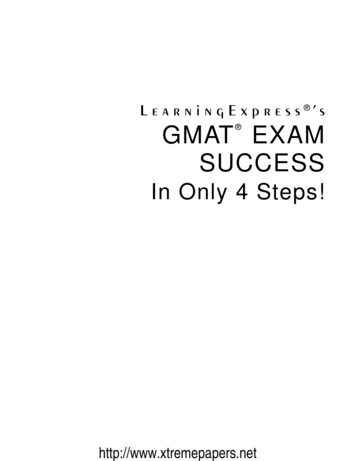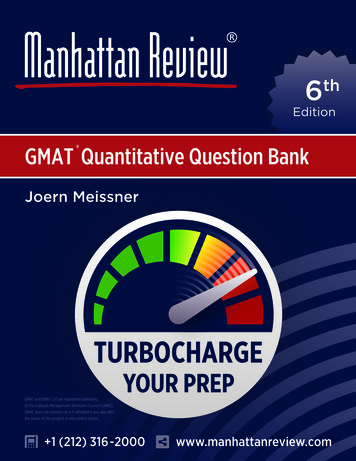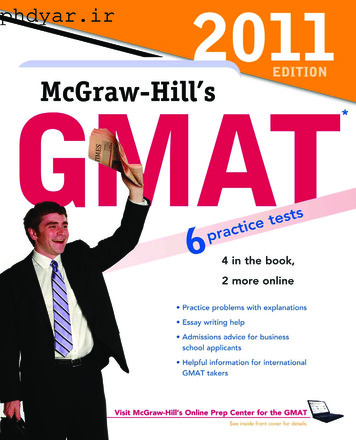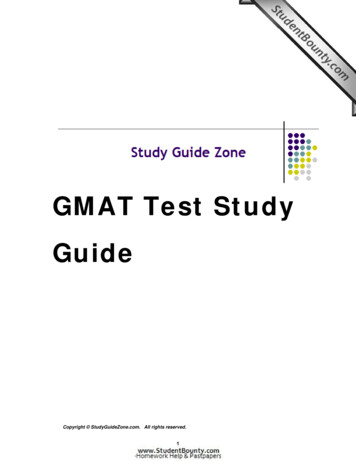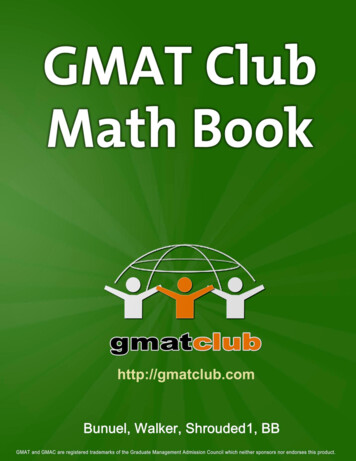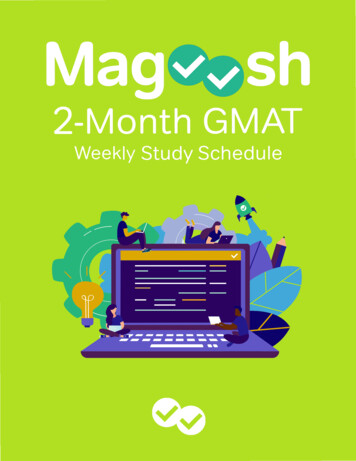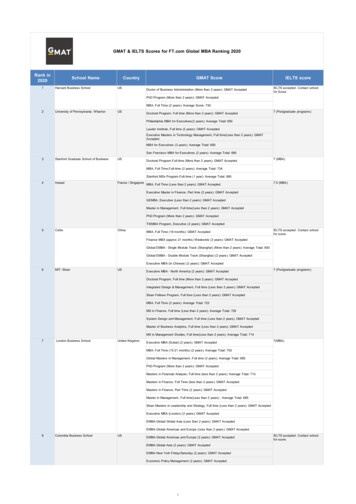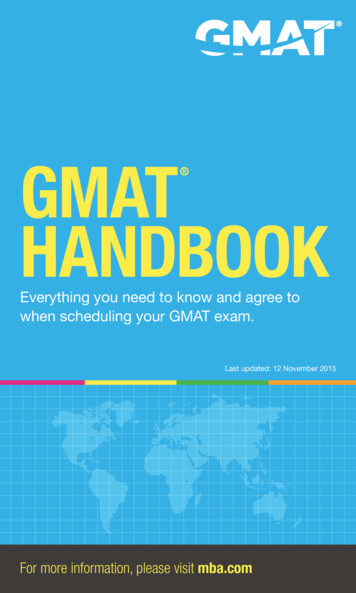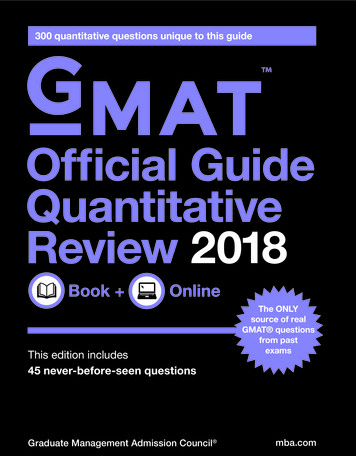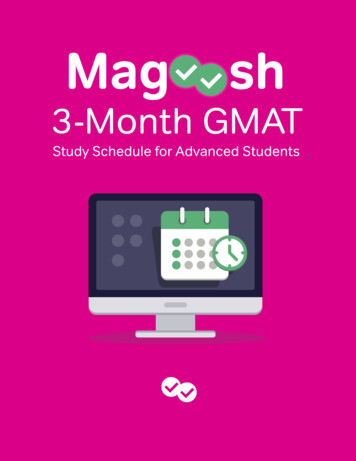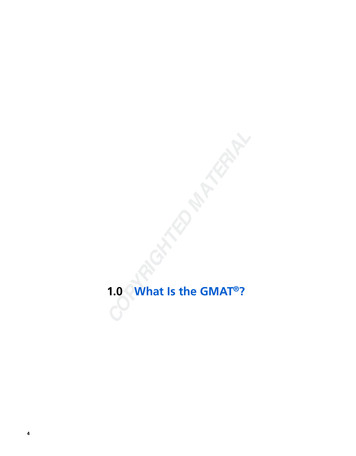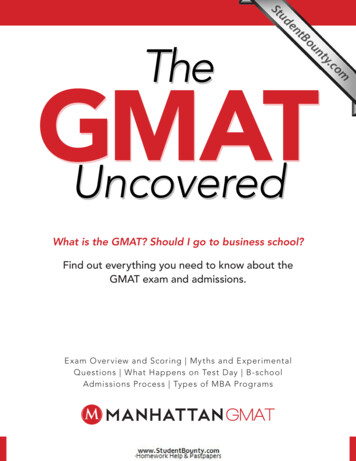
Transcription
TheGMATUncoveredWhat is the GMAT? Should I go to business school?Find out everything you need to know about theGMAT exam and admissions.E xam Over view and Scoring My ths and E xperimentalQuestions What Happens on Test Day B-schoolAdmissions Process Types of MBA Programs
The GMAT Uncovered10-digit International Standard Book Number: 1-937707-23-713-digit International Standard Book Number: 978-1-937707-23-1Copyright 2013 MG Prep, Inc.ALL RIGHTS RESERVED. No part of this work may be reproduced or usedin any form or by any means—graphic, electronic, or mechanical, includingphotocopying, recording, taping, Web distribution—without the prior writtenpermission of the publisher, MG Prep Inc.Note: GMAT, Graduate Management Admission Test, Graduate ManagementAdmission Council, and GMAC are all registered trademarks of the GraduateManagement Admission Council which neither sponsors nor is affiliated in anyway with this product.
Table of ContentsIntroduction5The Format of the Exam6Analytical Writing Assessment FormatIntegrated Reasoning FormatOptional Break #1Quantitative Section FormatOptional Break #2Verbal Section FormatReading ComprehensionScoringAnalytical Writing Assessment (AWA) ScoringIntegrated Reasoning ScoringThe GMAT Scoring Algorithm for the Quantitative and Verbal SectionsHow the Adaptive Algorithm Works: An OverviewDebunking a Myth: The Early Questions are NOT Worth MoreWhy Educated Guessing is ImportantExperimental QuestionsTopics Tested on the GMATAnalytical Writing Assessment (AWA)Integrated ReasoningQuantitativeVerbalWhat Happens on Test DayAt the Test CenterWhat to DO or AVOID on Test DayGeneral Business School Admissions ProcessHow Do Business Schools use the GMAT?Major Components of a Business School ApplicationManaging Your Time During the Application 952525455
Different Types of MBA ProgramsFull-Time ProgramsPart-Time ProgramsExecutive Programs60606162Visiting Schools62Interviews: What to Expect and How to Prepare63On Your Mark Get Set Go!68
IntroductionThe GMAT, or the Graduate Management Admission Test, is one of the key componentsof the business school application process. The test evaluates certain reasoning skills andacademic abilities of prospective MBA students, including general knowledge garneredduring college and high school; it does not include any business questions. This document provides a thorough introduction to the GMAT, including the test format, questiontypes, categories of knowledge tested, scoring algorithm, and more. It also examines thegeneral business school admissions process.The GMAT consists of four sections: Analytical Writing Assessment, Integrated Reasoning,Quantitative, and Verbal. The first section requires the student to compose an essay(typed), while the final three sections are all multiple-choice. The Quant and Verbal sections of the test are given in a Computer Adaptive format: the exam actually adapts itselfto each student as the student takes the test. Each of these two sections begins witha random question and the computer chooses each subsequent question based uponthe responses the student has given to that point in the test. Later in this document, wediscuss all of the test sections, as well as the Computer Adaptive format, in detail.The GMAT is administered 6 days a week, 52 weeks per year, for a fee of 250. While itisn’t offered on Sundays or holidays in most locations, certain testing sites may provideaccommodations for religious purposes; check www.mba.com for these and other detailsabout how to register for the exam. Essentially, you can take the GMAT whenever youwant, though you are limited to one test in any 31-day period, with a maximum of fivetests per 12-month period. (If you happen to score an 800, you won’t be allowed to takethe test again until your score expires 5 years later!)All together, the test itself lasts about three and a half hours: 30 minutes each for theAnalytical Writing Assessment and the Integrated Reasoning section, and 75 minuteseach for the Quantitative and Verbal sections. There are also two 8-minute breaks (beforeand after the Quant section). The sign-in security process and other procedures, such asselecting schools to receive score reports, can add up to an hour to the process.5
The Format of the ExamThe GMAT is comprised of four separate sections: the Analytical Writing Assessment,Integrated Reasoning, Quantitative, and Verbal. There are two optional 8-minute breaks:one before and one after the Quant section.Analytical Writing Assessment FormatThe GMAT begins with the Analytical Writing Assessment (AWA), which consists of anessay that is scored separately from the other test sections. The essay has a time limit of30 minutes and requires us to read an argument and analyze it.The essay score is based upon several factors:Analytical reasoning, including the ability to establish a thesis (take a position on theissue at hand) and develop your position with relevant examples and reasonsPresentation of your ideas, including appropriate organization of the information (anintroduction, body paragraphs with clear main points, a conclusion) and appropriateword choice to convey your ideas in a clear and crisp mannerCommand of the English language, including grammar, spelling, punctuation, andvocabulary (note: some accommodation is given to examinees whose first language isnot English)The Argument essay provides a one paragraph prompt in the form of an argument, witha conclusion and some premises intended to support that conclusion. The argumentprompt is often very similar to the Critical Reasoning arguments that appear on the Verbalportion of the exam. You are asked to indicate whether the argument is well-constructed(and it will not be well-constructed or there wouldn’t be much of an essay to write!) andyou are expected to describe and discuss flaws as well as suggest fixes.6
You are not asked to provide your opinion as to the “right” conclusion or the best wayto achieve the given conclusion. For example, if the argument says that a company plansto increase its profitability by firing half of its workers to reduce the amount it pays out insalaries, your task is not to say that this is a terrible plan to increase profitability, or thatthe company should do something else to improve profitability. Your task is simply toshow that the author of the argument has not provided sufficient evidence to support theclaim that action A (firing half of the workers) will actually lead to conclusion B (increasedprofitability). In other words, the author hasn’t provided enough information to indicatethat the plan is likely to succeed. It will always be the case that the evidence provided isnot fully sufficient; otherwise, it would be a very short essay.For instance, the author has not discussed the potential risks of such a plan. The test-takermight write: “The author assumes that there are not significant negative consequencesto the plan, consequences that could hinder the goal to improve profitability. Can thecompany still be as productive after losing half of the workers? Will the remaining workers demand higher salaries to compensate for the extra work they have to do, or simplyquit? In order to solidify the argument, the author needs to address concerns about thepotential risks that are tied directly to the plan.”Integrated Reasoning FormatThe Integrated Reasoning (IR) section is always the second section of the test. As with theessay, the time limit is 30 minutes. The IR section consists of four different question types,each with one or two different question formats. These questions cover both quantitativeand analytical reasoning skills — a cross between math and verbal. Some questions willmore closely resemble pure math or verbal questions while others will be a true mixtureof these skills. One major difference compared to standard quant and verbal questions,though, is that IR questions tend to provide extraneous information (information that wedon’t need to use in order to answer the question).The IR section will consist of 12 question prompts. Similar to a Reading Comprehensionpassage, where we are given multiple questions for one passage, we may be given7
multiple questions for one question prompt. We will have an average of 2.5 minutes toanswer each question.In this section, we discuss the IR question types and formats. Because of the nature ofthe way these problems are constructed, they cannot always be shown easily in a printedformat. Official examples can be found on the www.mba.com website and additionalexamples can be found on the ManhattanGMAT website.Multi-Source ReasoningOf the four question types, Multi-Source Reasoning (MSR) tends to be the most textheavy. These questions will provide two or three separate tabs of information; we willhave to switch between tabs in order to read the text. Some of the tabs may be purelytext; for example, an MSR prompt might consist of an email dialogue between two colleagues. Other MSRs will provide diagrams, tables, or graphs of information in one ormore of the tabs.MSR has two different question formats. First, there are regular multiple choice questions with the typical five options that we’re used to from the quant and verbal sectionsof the exam. Second, there are “multiple-dichotomous choice” questions. That sounds alot stranger than it is — “dichotomous” really just means “either-or.” For example, True/False questions are dichotomous questions. On these questions, we will be given somekind of “either/or” choice — True/False is one possibility, but other possibilities exist. Themultiple-dichotomous choice questions will come in sets of three; we have to answer allthree parts correctly in order to earn points for that question. On average, we will have atotal of 2.5 minutes to complete this three-question set.Table AnalysisAs might seem obvious from the title, Table Analysis (Table) questions consist of tableswith some amount of text explaining the table or providing other information. Anyexplanatory text will not be long but it may contain very important information — makesure to read it. The tables will resemble spreadsheets, often with 5 or 6 (or more!) rows8
and columns. The columns will be able to be sorted, and it will almost certainly be necessary to do so in order to determine correct answers to the questions.Table problems will also present three multiple-dichotomous choice questions, similar toMSR; again, we have to answer all three correctly in order to gain any points on the problem and, on average, we will have a total of 2.5 minutes to complete this three-questionset. These questions will tend to be a little bit more quantitatively focused, covering suchtopics as statistics, ratios, probabilities, correlations, and so on — though inference andother verbal questions are still possible.Graphics InterpretationEach Graphics Interpretation (GI) question will provide some type of graph; possiblegraph types include bar graphs, line graphs, scatterplots, and bubble graphs. More complex graphs might have two y-axes with two different scales, one on the left and one onthe right. There may also be additional text explaining what the graph represents andproviding other important information. As with Table questions, this extra text will not belong but will likely be crucial to understanding the problem. In fact, it is often valuable toread the text first in order to help avoid misreading or misinterpreting the graph.GI questions will consist of one or two statements (sentences) containing a total of twoblanks, and we have, on average, a total of 2.5 minutes to answer these two-part questions. There may be one sentence containing two blanks or two sentences each containing one blank. Each blank will have a drop-down menu from which the test-taker picks ananswer. It is often very helpful to look at the options before beginning to try to answerthe question; knowing what the answer options are is often integral to an efficient andeffective approach to the solution.Two-Part AnalysisTwo-Part Analysis (TP) questions can closely resemble either standard Problem Solvingmath questions or Critical Reasoning or Reading Comprehension verbal questions, orthey can be a mix of quant and verbal.9
The answer choices are presented in an unusual way, unique to TP: we’re given a 3-columntable with up to 6 possible answers shown in one column, and from these we will needto choose answers to two different questions (listed in two different columns). These twoquestions are often closely related; for instance, we might be asked to find the valuesfor two different variables in the problem, or we might be asked to find an answer thatrepresents an assumption and another answer that would strengthen that assumption.As with other question types, we must answer both of these parts correctly in order toearn points on the problem, and we have a total of 2.5 minutes, on average, to answerboth parts of the question.Optional Break #1Test-takers are offered two optional 8-minute breaks. The first occurs between theIntegrated Reasoning and Quantitative sections. If you would like to take the break, raiseyour hand, and a proctor will escort you out of the testing room (you cannot stay in thetesting room during the break). If you do not want to take the break, select the option onthe screen to skip it.It is strongly recommended that you take advantage of this time. If nothing else, it isimportant to have a small mental break from the stresses of the exam. This also givesyou an opportunity to have something to eat or drink, to stretch, and to refresh yourselfbefore beginning the next section. Also, when you take practice tests, shorten your breaksto about five minutes (or else add in a minute or two of waiting and walking around tosimulate the proctor checking you in and out of the room).Quantitative Section FormatFollowing IR is the Quantitative section, during which you will be asked to answer 37questions in 75 minutes (on average, about 2 minutes per problem). This section marksthe beginning of the adaptive testing format: every test taker will take a different examwith a different mix of questions, chosen based upon your prior performance as you workyour way through the exam. The quantitative questions will come in two different formats,Problem Solving and Data Sufficiency, and the two question types can be presented in10
any order. Test-takers are generally offered between 20 and 22 Problem Solving questions and between 15 and 17 Data Sufficiency questions.Both question types can vary from quite easy to extremely difficult, but every problem hasa solution method that will take two minutes or less, though not everyone will discover orbe capable of executing that method in that timeframe. In general, as questions becomemore difficult, two things will separate those who get the question right from those whoget it wrong: knowledge of the quantitative content being tested and knowledge of theoptimal solution method. Timing strategies will be discussed in more detail later in thisdocument.Problem SolvingProblem Solving questions require you to set up and complete any necessary calculationsin order to find a specific numeric or algebraic answer, which will be located among fiveanswer choices provided with the problem. An example of a Problem Solving questionand solution appears below.Problem:1727 has a units digit of:(A)(B)(C)(D)(E)1237911
Solution:When raising a number to a power, the final units digit is influenced only by the units digitof that starting number. For example 142 ends in a 6 because 42 also ends in a 6.1727 will therefore end in the same units digit as 727. The units digit of consecutive powersof 7 follows a distinct pattern; your task is to find that pattern:Power of 7Units digit717729733741757 (repeat!)The pattern repeats after 4 powers, so every multiple power of 4 will end in the sameunits digit. For example, the units digit of 78 is 1, and the units digit of 712 is also 1. Find thelargest power of 4 that is still smaller than your desired exponent, 27. The largest powerof 4 that is still smaller than 27 is 24, so 724 has a units digit of 1. Count out the pattern onthe chart (ignoring the fifth row, which is a repeat of the pattern): 725 has a units digit of7, 726 has a units digit of 9, and 727 has a units digit of 3. The correct answer choice is (C).Data SufficiencyData Sufficiency questions require you to understand (a) how to set up a problem and (b)whether the problem can be solved with the given information. You do not actually needto solve the problem as you would with a Problem Solving question. In fact, you shouldnot spend time completing the necessary calculations for these questions as you willthen be unable to finish the test in the given amount of time. For example, if the questionasks how old Sue is and provides the information that (1) Joe is 12 and (2) Jim is 18, thenyou cannot solve for the unknown value: Sue’s age. If the information, however, tells youthat (1) Joe is 12 and (2) Joe is 4 years younger than Sue, then you can solve for Sue’s age,12
but you shouldn’t spend time doing so. Sue’s age will not actually appear in any of theanswer choices; rather, the correct answer choice will indicate that you need both datapoints (1) and (2) in order to solve the problem.Data Sufficiency problems can be worded in one of two main ways: as value questions oras yes/no questions.TypeValue: How oldis Sue?Yes/No: Is Sue16 years old?DescriptionExampleSufficient data will allow you tocalculate one unique value for theunknown in questionSufficient: Joe is 12 andJoe is 4 years youngerthan SueInsufficient data will allow you tocalculate either zero values or morethan one value for the unknown inquestionNot sufficient: Joe is 12and Jim is 18Sufficient data will allow you todetermine that the answer is eitheralways yes or always noSufficient: Sue isbetween 20 and 25years of ageInsufficient data will allow you todetermine that the answer is maybe:sometimes yes and sometimes noNot Sufficient: Sue isbetween 15 and 20years of ageA full example of a value Data Sufficiency problem and solution is on the following page.13
Problem:What is the greatest common factor of positive integers a and b?(1) a b 4(2) b/4 is an integer(A) Statement (1) ALONE is sufficient, but statement (2) alone is not sufficient.(B) Statement (2) ALONE is sufficient, but statement (1) alone is not sufficient.(C) Both statements TOGETHER are sufficient, but NEITHER oneALONE is sufficient.(D) EACH statement ALONE is sufficient.(E) Statements (1) and (2) TOGETHER are NOT sufficient.Solution:First, it’s important to be aware that the five answer choices shown above are exactlythe same on every data sufficiency problem. The text is identical and the order of theanswers is always the same — for example, answer choice (A) always says that statement1 is sufficient alone but statement 2 is not. You can, and should, memorize the answerchoices before you go into the exam.Factors are integers that divide evenly into other integers. For example, 4 is a factor of8 because 8/4 2, an integer with no remainder. 3 is a factor of 9 because 9/3 3, aninteger with no remainder.The greatest common factor of two numbers is the largest factor that is common to bothnumbers. For instance, the greatest common factor of 4 and 8 is 4, because 4 is the largest factor that divides evenly into both numbers. The greatest common factor of 8 and 12is also four, because 4 is the largest factor that divides evenly into both numbers.Examine statement (1) alone first. If you try some numbers, you can see the fact that a b 4 leaves you with multiple possible answers to the question. For instance, if b is 414
and a is 8, then the greatest common factor is 4. If, however, b is 5 and a is 9, then thegreatest common factor is 1. Statement (1), by itself, is insufficient to answer the question;eliminate answer choices (A) and (D).Next, examine statement (2) by itself. This statement indicates that b/4 is an integer buttells you nothing about the value of a. As a result, you cannot tell what the greatestcommon factor of the two might be. Statement (2), by itself, is insufficient to answer thequestion; eliminate answer choice (B).Finally, examine the two statements together. Statement (2), b/4 is an integer, indicatesthat b is a multiple of 4, though it does not tell you an exact value for b. Statement (1) tellsyou that, whatever b is, a is exactly 4 greater than b. If a is always 4 greater than b, then amust also be a multiple of 4, and a must also be the next consecutive integer multiple of4. For example, if b is 4, a is 8. If b is 8, a is 12.You can solve this problem if you know a certain number principle (one that you areexpected to know for the GMAT): for any two positive consecutive multiples of an integern, n is also the greatest common factor of those multiples. Because you know that b anda, respectively, represent two positive consecutive multiples of the integer 4, then 4 is thegreatest common factor of b and a.Bonus exercise: see if you can figure out why the principle discussed in the previousparagraph is always true.Optional Break #2The second of the two optional breaks occurs between the Quantitative and Verbalsections. The procedure will be the same as during the first optional break. Again, it isstrongly recommended that you take the break.15
Verbal Section FormatAfter the Quantitative section, you will face the Verbal section, during which you areexpected to answer 41 questions in 75 minutes (on average, slightly less than 2 minutesper question). The verbal questions will come in three different formats — SentenceCorrection, Critical Reasoning, and Reading Comprehension — and the three questiontypes can be given in any order (though the questions associated with one ReadingComprehension passage will always be grouped together). In general, test-takers aretypically offered 14 to 15 Sentence Correction questions, 13 to 14 Critical Reasoningquestions, and 12 to 14 Reading Comprehension questions.Verbal questions ask you to find the best answer among the given five answers (as opposedto the right answer, as in the Quantitative section); essentially, for verbal questions, theright answer is better than each of the other four. As such, process of elimination is crucialto a strong performance on the Verbal section. The correct answer may not be what youwould have thought of on your own, but it will be better than the other four choices.Sentence Correction questions require you to know certain grammar rules in advance ofthe exam; you must bring this knowledge into the exam with you, in the same way thatyou must memorize the formula for the area of a circle. You will also need to pay attentionto the clarity of the meaning expressed in the sentence. By contrast, Critical Reasoningand Reading Comprehension questions do not require any outside knowledge; thesequestions can (and should) be answered from the information provided in the accompanying text, as well as your general reasoning and comprehension skills.16
Sentence CorrectionSentence Correction questions test you on your knowledge of English grammar andmeaning, including the topics listed in the below table. These questions also occasionallytest the meaning of a sentence, as well as bject-Verb AgreementVerb Tense, Mood, and VoicePronounsIdiomsConnecting Words and PunctuationQuantity ExpressionsSentence Correction questions begin with a single sentence, some portion of which isunderlined (possibly the entire sentence). Answer choice (A) always repeats the underlined portion of the sentence with no changes; this answer is the equivalent of saying thatthere is no error in the original sentence. Answer choices (B) through (E) offer alternativesfor the underlined portion; by choosing one of these, the test-taker is indicating that theoriginal underlined portion contained an error. An example of a Sentence Correctionquestion and solution appears on the next page.17
Problem:The number of acres destroyed by wildfires, which have become an ongoingthreat due to drought and booming population density, have increaseddramatically over the past several years, prompting major concern amonglocal politicians.(A) have become an ongoing threat due to drought and boomingpopulation density, have increased(B) has become an ongoing threat due to drought and boomingpopulation density, has increased(C) has become an ongoing threat because of drought and boomingpopulation density, has been increasing(D) has become an ongoing threat due to drought and boomingpopulation density, have increased(E) have become an ongoing threat because of drought and boomingpopulation density, has increasedSolution:The original sentence begins with the main subject “the number (of acres).” “The number” is singular, so the main verb should match. In the original sentence, however, themain verb is “have increased.” “The number have increased” is not an appropriate match;it should be “the number has increased.” Eliminate answer choice (A) (representing theoriginal sentence), as well as answer choice (D), which repeats the error.The original sentence contains a “wildfires, which have become ” construction, indicating that the words following “which” should refer to the main noun preceding the comma.The noun “wildfires” precedes the comma, and the verb “have become” follows “which.”“Wildfires” and “have become” are both appropriately plural, so this is an acceptablematch. Answer choices (B) and (C), however, change this verb to “has become,” which isincorrect. Eliminate answer choices (B) and (C).18
That leaves you with answer choice (E) as the only remaining choice. (E) correctly says that“wildfires have become” and that “the number has increased.”Below is a table showing the main sentence components (based upon the wording of theoriginal sentence):Critical ReasoningCritical Reasoning questions (also called arguments) present test-takers with a short paragraph of information. These arguments contain a number of what we call building blocks.First, we have premises, information designed to support the argument’s conclusion.Premises may be data, facts, or other information, and may also include some claims oropinions. Most arguments — though not all — also contain a conclusion, the primary claimmade by the author of the argument. In general, most premises and claims are designedto support the argument’s conclusion, though sometimes the information goes againstthe argument’s conclusion; when this occurs, the information is called a counter-premise.Arguments also rest upon certain assumptions, which are not stated in the argument butwhich the author believes to be true. For instance, if Sue states that cats make the bestpets, then Sue is also assuming (but not stating explicitly) that dogs do not make betterpets than cats.premisefacts or claims designed to support theauthor’s conclusioncounter-premisefacts or claims that go against the author’sconclusionassumptionnot stated in the argument; information theauthor must believe to be true in drawing acertain conclusionconclusionthe primary claim made in the argument19
Descriptions of the various Critical Reasoning question types are listed in the following tables. We’ve organized the question types into three overall Families: Structure,Assumption, and Evidence. Each family contains two or more question types.The Structure-Based-FamilyThese arguments contain both premises and conclusions and often contain counterpremises or some type of counter-argument as well. The answers are often presentedin somewhat abstract language; they will often directly refer to conclusions claims, facts,opinions, and so on. The correct answer depends upon being able to understand thestructure of the argument, and the way in which a certain piece of information is used(e.g., as a premise, as a counter-premise, and so on).TypeDescribe the RoleDescriptionYour task is to understand the role that some subset ofthe argument plays in the context of the overall argument. The subset in question will be presented in boldfaced font, and the correct answer will explain how thattext relates to the overall argument.Describe the Argument This is a minor type. Most Describe the Argument questions will follow this format: one person claims somethingand a second person responds; you are typically asked tofind the answer that explains how the response relates tothe original claim.The Assumption-Based FamilyAssumption Family questions all contain conclusions as well as unstated assumptions.The key to correctly answering these questions will lie with discovering the necessaryunstated assumption. An assumption is something the author assumes must be true inorder to draw that conclusion, but he or she does not actually state that assumption inthe argument. Note that the assumption does not need to be true in the real world; itmerely needs to be something the author must believe in drawing the given conclusion.20
Question TypeFind theAssumptionEvaluateFlawDescriptionExampleWe’re tasked with findingsomething that the authormust assume to be true inorder for the author to drawthat conclusion.Argument: Sue is less than sixfeet tall. Therefore, she will notbe chosen for the basketballteam.Assumption: One must be atleast six feet tall in order tobe chosen for the basketballteam.We’re asked to find ananswer that will help todetermine whether theauthor’s conclusion is valid.The correct answer willusually be in “either/or” formand can both strengthenand weaken the argument.Argument: Sue is less than sixfeet tall. Therefore, she won’tbe successful as a member ofthe basketball team.The “flip side” of Find theAssumption: find somethingthat the author must assumeto be true but pr
5 Introduction The GMAT, or the Graduate Management Admission Test, is one of the key compone nts of the business school application process. The test evaluates certain reaso ning skills and
